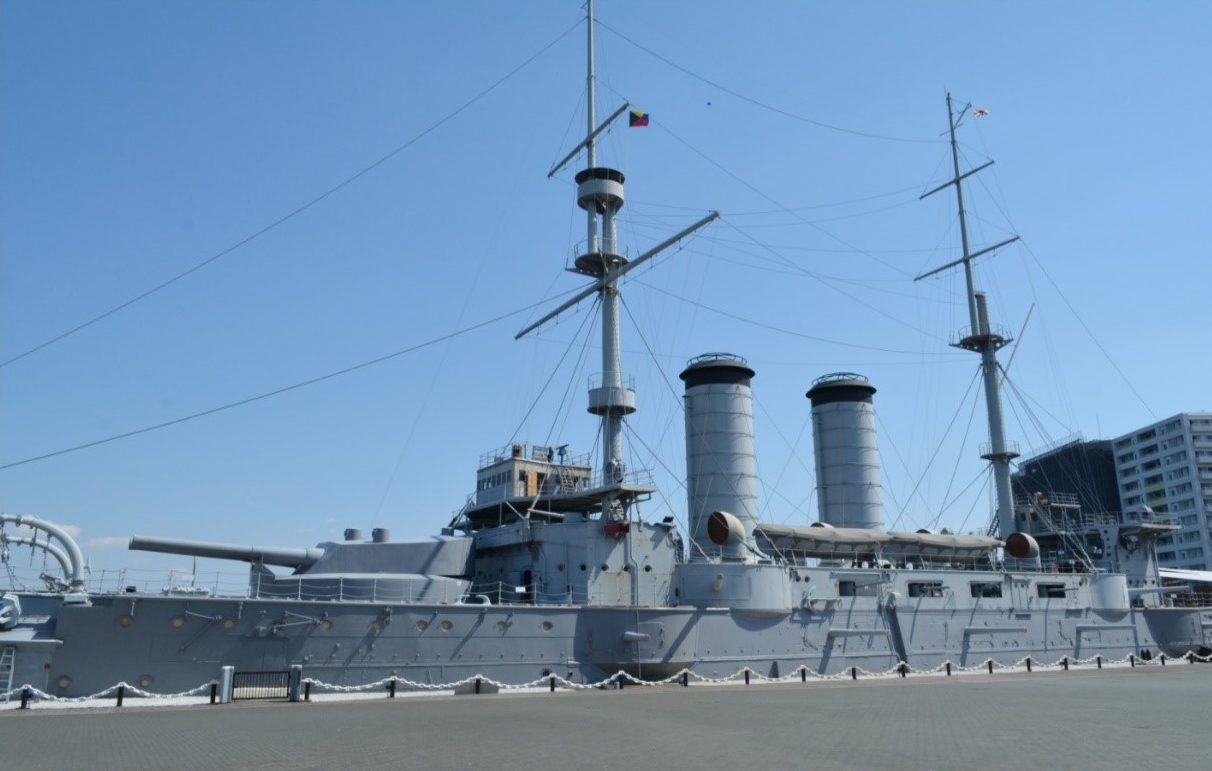企業戦略 2020.06.22
CS11 「海軍カレー」の父 The Father of ”Naval Curry”
目次
Copyright © Shinichiro Hatani 2020 All rights reserved
For those who prefer to read this column in English, the Japanese text is followed by a British English translation, so please scroll down to the bottom of the Japanese text.
1885年(明治18年)3月、海軍軍医総監であった高木兼寛は、現在パンデミックの新型コロナと同様、当時「原因・対処方、いずれも不明の死の病」と恐れられた脚気には、「洋食と麦飯を食べればよい」とする自説を発表したが、無定見かつ大きな批判の嵐に曝された。
しかし、当時、日本の同盟国であった英国のジャーナリストらから「東洋のネルソン」と呼ばれた東郷平八郎他、英国に留学していた多くの海軍士官からその説は支持を受け広がり、劇的な脚気の症状の改善を海軍では見たが、「ビタミン発見へ繋がる偉業」として彼の正しさが証明されたのは、日露戦争後のことであった。

1. 海軍カレー
脚気は白米を主食とすることによる病気で江戸時代にあらわれ、明治になって増加した。特に兵役に服する若者に多く発生、陸海軍にとっても解決すべき大きな課題となっていた。
当時、陸軍は東大とともに細菌学中心のドイツ式の医学を採用していたのに対し、海軍では病気を生活環境との関係で捉える疫学を中心にした英国式の医学を採用していた。
明治13年、高木が英国留学から帰国したとき、海軍では全兵員の3分の1が脚気の患者であり、年に30名以上が亡くなっていた。高木は英国に脚気患者がいないこと等から、兵士の食事に原因があると考え、予防策として麦飯や当時なじみの薄かった「カレー」を取り入れることを提案した。兵士の食習慣等が障害になってすぐには受け入れられなかったが、粘り強く上層部を説得し続けた。脚気で乗員の一割が亡くなることが起きていたのが遠洋航海。しかし、明治17年に出帆した軍艦「筑波」では、兵食の改善により、「乗組員333名中脚気死亡者なし」という画期的な成功を収め、脚気問題は解決していった。
一方、陸軍上層部では脚気の原因を「細菌によるもの」と高木の考えを全く受け入れなかった。しかし、各地の部隊では高木の研究を参考に現場の軍医の判断によって兵食が改善され、明治21年には陸軍の各部隊で脚気は激減、陸軍省医務局の反対にもかかわらず、明治24年には全部隊が麦飯を採用して陸軍の脚気も絶滅状態になった。しかし、当の医務局は因果関係を認めず、単に「流行の沈静」と捉え、その後も兵食の改善をしなかったため、全軍同じ兵食が配給された日露戦争では脚気による陸軍の被害は甚大となった。陸軍で約25万人が脚気にかかったのである。陸軍の戦死(即死)者4万8000名に対して傷病死者3万7200名、うち脚気による死者は2万7800名にのぼった。対して、海軍の脚気患者は僅か105名であった。
高木は、日本の医学界がドイツ医学一色で学理研究優先になっているのを憂い、臨床第一の英国医学と患者本位の医療を広めるため成医会講習所を設立した、現在の東京慈恵会医科大学の源流である。
2. 本質を見抜く眼
「眼前の患者を救い得ないならば、いかなる支配的学説も無用の長物にすぎないこと」を高木は自ら実証した。「本質は何か」を現場主義で証明したのである。グローバル・リンクが掲げる「リスクマネジメント」もまさに同じく「リスクマネジメントの本質は何か」である。
とかく、リスクマネジメント、また経営学や経営戦略論等は「欧米発」が多いため、横文字が多く、そのため実際のリスクマネジメント戦略の策定においても、「学理研究」のような現場を無視した事例を見る機会が多い。
「リスクマネジメント」と言っても煎じ詰めれば、如何に正確に企業の内外を分析して、競合する企業の戦略、行動を的確に読み、対抗、勝っていくかであり、その為には「本質を見抜く眼」が必須である。高木のように「支配的学説」にさえ挑戦して本質を見極めていこうとする強い意志、そして何よりも本質を見抜く眼がなくては競合優位を極める企業戦略の構築は不可能、唯の「絵に描いた餅」にしかならないからである。

3.正視眼経営を
競争戦略論の第一人者であるマイケル・E・ポーター、ハーバード大学ビジネス・スクール教授は、自著「競争の戦略」のなかで、競合優位性を発揮するためには、①コスト・リーダーシップ、つまり低価格化、②集中化、そして③差別化、この三つの戦略しかないと断じている。
現代は、顧客ニーズに合わない商品をいくら作っても売れない時代。しかし、いまだに過去の成功体験に溺れ、独りよがりの商品を出して「売れない」と言っている企業が多い。長年、「護送船団体制」であったためか、金融業界では競合優位性のある企業戦略を構築している企業は少ないと感じる。市場開発機能の本質が理解されておらず、販売チャネルを志向した「販売、営業戦略」ばかりが立案され、顧客ニーズに立脚した「マーケティング戦略」が策定されていない金融機関が実に多いからである。
経営は「舵取り」という言葉で表される、大海原を航海するに等しいからである。タイタニック号の事件では、「マストに昇った見張りが双眼鏡を忘れていたこと」が後年判明、氷山衝突の主たる原因とされた。先を見るには極寒の地でもマストに昇らなければならない、ぬくぬくとした船室で「遠く」を見ることはできない。
その覚悟を経営が担っているか否かが企業の命運を握る。「企業戦略 5 ー戦略ドメイン(事業の定義)」において、「近視眼的マーケティング」とセオドア・レビット、ハーバード大学名誉教授が指摘した「米国鉄道会社」の例を引いて、「なぜ鉄道会社が衰退したか、それは戦略ドメインの定義に失敗したからである」と述べた。
マーケティングの概念が「広告宣伝と同義語」になっている傾向が強く、企業経営のなかに充分醸成されているとは言い難い日本企業。近視眼ではなく、寒風吹きすさぶ地においてもトップ自らがマストに立ち「正視眼」で「リスクを見る、図る、対応する」必要があるのではないだろうか。
今回のまとめ
コロナ渦のなか、来年9月のロンドン便を予約した。キャプティブの再保険の件でそのロンドンを訪れる度に向かう場所に「Brick Lane」がある。通りの両側に多くのカレーレストランがある。通りに近づくとカレーの香ばしい香りが鼻をつく場所である。カレーの本場、インドの旧宗主国のためか、ロンドン中至るところにカレーレストランがある。
面白いことにカレーはインド料理であるが、ロンドンのほとんどすべてのカレーレストランを経営しているのはインド人ではない、バングラデッシュ人だと言われている。「インドのカレーは辛すぎて食べれない」からだそうである。
リスクに関しても同じような「思い込み」はないだろうか、リスクマネジメントをおこなうときは、すべての思い込みを廃して「ゼロベース」でリスクの検証をすることが肝要である。それなくしてはその後のマネジメントで大きく方向を間違ってしまう可能性があるからである。だからこそ、「大命題」が必要であるとグローバル・リンクは考える。
「ただのリスクマネジメント」は「ただの結果」に終わる可能性が高い、「大きな目的を大上段に掲げてこそ、正視眼によるリスクマネジメント」ができる。その大命題こそ「キャプティブの設立」であるとグローバル・リンクは考えている。
執筆・翻訳者:羽谷 信一郎
English Translation
Corporate Strategy (CS) 11 – The Father of ”Naval Curry”
In March 1885, Dr. Kanehiro Takagi, a naval physician-in-chief, published his own theory that Western food and barley rice would be the best way to treat beriberi, which was feared at the time to be a “deadly disease of unknown cause and prescription,” as is now the case with the new corona, but this theory was met with a storm of criticism and lack of judgment.
However, many naval officers studying in England, including Heihachiro Togo, known as the “Nelson of the East” by British journalists who were allies of Japan at the time, supported his theory and it spread, and the navy saw a dramatic improvement in the symptoms of beriberi. However, it wasn’t until after the Japanese-Russo War that he was proven correct as a “feat leading to the discovery of vitamins”.
The beriberi appeared in the Edo period as a disease caused by eating white rice as a staple food, and it increased in the Meiji period. The disease was particularly prevalent among young men serving in the military, and it was a major problem for the army and navy to be solved.
At the time, the Army, along with the University of Tokyo, had adopted German-style medicine, focusing on bacteriology, while the Navy had adopted British-style medicine, focusing on epidemiology, which understood disease in relation to the living environment.
When Takagi returned to Japan in 1883 after studying in England, one-third of all soldiers in the Navy were suffering from beriberi, and more than 30 had died each year. Since there were no cases of beriberi in England, Takagi believed that the cause of the problem lay in the diet of the soldiers, and suggested the introduction of barley rice and curry, which was not widely known at the time, as preventive measures. The soldiers’ eating habits and other factors were obstacles to their acceptance, but they persisted and continued to persuade their superiors. Ten percent of the crew had died from foot fever on ocean voyages. However, the warship Tsukuba, which set sail in 1881, achieved a breakthrough in the area of beriberi, with no deaths from beriberi among its 333 crew members, thanks to improvements in the food supply.
On the other hand, the upper echelons of the army did not accept Takagi’s idea, believing that beriberi was caused by bacteria. However, units around the country improved their military diet based on Takagi’s research, and by 1888, foot fever was dramatically reduced in each unit of the army, and despite the opposition of the War Ministry’s Medical Bureau, all units adopted wheat rice in 1894, and the army’s foot fever became extinct. However, the Medical Bureau did not acknowledge a causal relationship between the two, and simply regarded it as a “calming down of the epidemic,” and did not improve the food supply for the soldiers afterwards. In the Russo-Japanese War, the army suffered greatly from beriberi, a disease that affected about 250,000 men in the army. Of the 48,000 killed (killed instantly) in the army, 37,200 were wounded or sick, of which 27,800 were killed by the beriberi. In contrast, only 105 naval personnel suffered from foot fever.
He established the Seiikai Training School to spread the clinical-oriented British medicine and patient-oriented medicine, which is the origin of the present Jikei University School of Medicine.
2. Eyes that see through the essence
Takagi himself demonstrated that “any dominant theory is useless if it cannot help the patient in front of it. He proved what the essence of the practice is through his hands-on approach. Global Link’s risk management is also based on the same principle: “What is the essence of risk management?
This is why risk management, business administration, and management strategy theory are often described as “Western” and therefore are often written in Western language, and for this reason, there are many examples of risk management that ignore the reality of the situation on the ground, such as academic research, when formulating risk management strategies.
In other words, risk management requires an accurate analysis of the inside and outside of a company, an accurate understanding of the strategies and actions of competing companies, and an ability to counter and win. Without the strong will to challenge the “dominant theory” and discern the essence, as Takagi does, and without an eye for discerning the essence, it is impossible to build a corporate strategy that will allow us to gain a competitive advantage.
3. Management with a clear vision
Michael E. Porter, a leading authority on competitive strategy and a professor at Harvard Business School, argues in his book “Strategies for Competition” that there are only three strategies for achieving competitive advantage: (1) cost leadership, (2) concentration, and (3) differentiation.
Today, it doesn’t matter how many products you make that don’t meet customer needs, you can’t sell them. However, many companies are still drowning in the successes of the past, offering self-satisfied products and saying that they won’t buy them.. Perhaps because we have been in a “convoy system” for many years, I feel that few companies in the financial industry have developed corporate strategies that give them a competitive advantage. This is because many financial institutions do not understand the true nature of the market development function, and instead only devise sales and marketing strategies that are oriented toward sales channels, but do not formulate marketing strategies that are grounded in the needs of their customers.
This is because management is equivalent to sailing the ocean, which is described by the word “steering”. In the Titanic incident, it was later discovered that the main cause of the iceberg collision was that the watchman on board of the Titanic had forgotten his binoculars. In order to see the future, you have to climb the mast, even in the extreme cold, and it is impossible to see “far away” in a warm cabin.
The fate of a company depends on whether or not its management is prepared to do so. In Corporate Strategy 5: Strategic Domain (Definition of Business), Theodore Levitt, Professor emeritus of Harvard University, referred to the example of the U.S. railroad companies as “short-sighted marketing” and said, “The reason for the decline of the railroad companies is that they failed to define their strategic domain”.
Summary of this issue
In the midst of the Corona ravages, I booked a flight to London next September. Every time I visit London for the captive reinsurance, there is a place called “Brick Lane”. There are many curry restaurants on both sides of the street. When you approach the street, the smell of curry can be very attractive. There are curry restaurants all over London, probably because of the former sovereignty of India, the home of curry.
Interestingly, although curry is an Indian dish, it is said that almost all of London’s curry restaurants are owned by Bangladeshi people, not Indians. They say it’s because “Indian curry is too hot to eat”.
It is important to eliminate all assumptions and examine risks on a “zero” basis when conducting risk management. Without this, there is a possibility that subsequent management will be greatly misdirected. This is why Global Link believes that a “grand proposition” is necessary.
There is a high probability that “mere risk management” will end up as “mere results.” “Risk management with a clear vision” is possible only when a large objective is set at the top of the list. Global Link believes that this major proposition is the establishment of a captive.
Author/translator: Shinichiro Hatani

